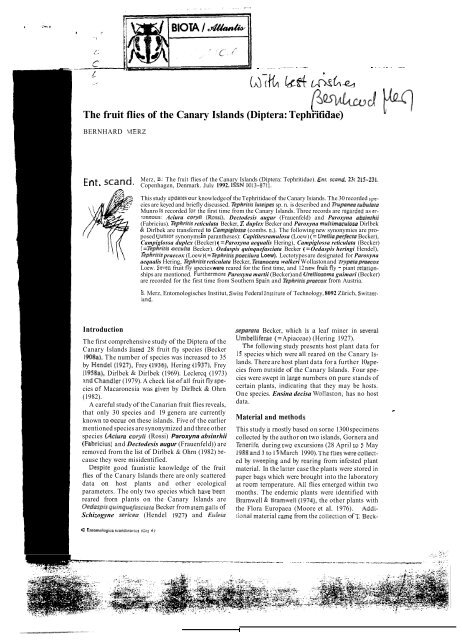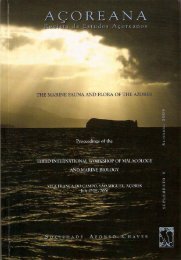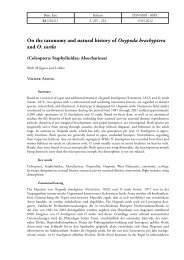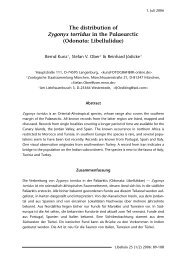Create successful ePaper yourself
Turn your PDF publications into a flip-book with our unique Google optimized e-Paper software.
~ . . - .- . . . . . __<br />
pQ&C.i?J <strong>pq</strong><br />
The fruit flies of the Canary Islands (Diptera: Tephritidae)<br />
BERNHARD MERZ<br />
stand. Copenhagen, Denmark. July 1992. ISSN OO13-87l1.<br />
Merz, B.: The fruit flies of the Canary Islands (Diptera: Tephritidae). Ent. scand. 23: 215-231.<br />
This study updates our knowledge of the Tephritidae of the Canary Isiands. The 30 recorded spe-<br />
cies are keyed and briefly discussed. iephritis lureipes sp. n. is described and Trupanea tubulata<br />
Munro is recorded for the first time from the Canary Islands. Three records are regarded as er-<br />
roneous: Aciura coryli (Rossi), Dectodesis augur (Frauenfeld) and Paroxyna absinthii<br />
(Fabricius). Tephritis reticulata Becker, 7: duplex Becker and Paroxyna rnulrirnuculosu Dirlbek<br />
& Dirlbek are transferred to Cumpiglossu (combs. n.). The following new synonymies are pro-<br />
posed (junior synonyms in parantheses): Capititesramulosa (Loew) (= Urelliaperfecta Becker),<br />
Campiglossa duplex (Becker) ( = Paroxyna aequalis Hering), Campiglossa reticulata (Becker)<br />
( = Ephritis occuíta Becker). Oedaspis quinquefasciata Becker ( = Oedaspis heringi Hendel),<br />
Ephritis praecox (Loew) (=íéphritispoecilura Loew). Lectotypes are designated for Paroxyna<br />
aequalis Hering, iephritis reticulata Becker, Tetanocera walkeri Wollaston and Pyperapraecox<br />
Loew. Seven fruit fly species were reared for the first time, and 12 new hit fly - piant reiation-<br />
ships are mentioned. Furthermore Paroxyna martii (Becker) and Urelliosomn guimari (Becker)<br />
are recorded for the first time from Southern Spain and iephritispraecox from Austria.<br />
B. Merz, Entomologisches Institut, Swiss Federal Institute of Technology, 8092 Zürich, Switzer-<br />
land.<br />
Introduction separara Becker, which is a leaf miner in several<br />
The first comprehensive study of the Diptera of the<br />
Canary Islands listed 28 fruit fly species (Becker<br />
1908a). The number of species was increased to 35<br />
by Hendel(1927), Frey (1936), Hering (1937), Frey<br />
(1958a), Dirlbek & Dirlbek (1969). Leclercq (1973)<br />
andchandler (1979). A check list ofall fruit flyspe-<br />
cies of Macaronesia was given by Dirlbek & Ohrn<br />
(1982).<br />
A careful study of the Canarian fruit flies reveals,<br />
that only 30 species and 19 genera are currently<br />
known to occur on these islands. Five of the earlier<br />
mentioned species are synonymized and three other<br />
species (Aciura coryli (Rossi) Paroxyna absinrhii<br />
(Fabricius) and Dectodesis augur (Frauenfeld)) are<br />
removed frorn the list of Dirlbek & Ohrn (1982) be-<br />
cause they were misidentified.<br />
Despite good faunistic knowledge of the fruit<br />
flies of the Canary Islands there are only scattered<br />
data on host plants and other ecological<br />
parameters. The only two species which have been<br />
reared frorn plants on the Canary Islands are<br />
Oedaspisqutnquefasciata Becker from stem galls of<br />
Schizogyne sericea (Hendel 1927) and Eirleiu<br />
0 Entomolooica rcandmi.r~ca itirp 6)<br />
Umbelliferae (= Apiaceae) (Hering 1927).<br />
The following study presents host plant data for<br />
15 species which were al1 reared on the Canary Is-<br />
lands. There are host plant data for a further 10 spe-<br />
cies frorn outside of the Canary Islands. Four spe-<br />
cies were swept in large nurnbers on pure stands of<br />
certain plants, indicating that they may be hosts.<br />
One species. Ensina decisa Wollaston, has no host<br />
data.<br />
Material and methods<br />
This study is rnostly based on sorne 1300 specimens<br />
collected by the author on two islands, Gornera and<br />
Tenerife, during two excursions (28 April to 5 May<br />
1988and3 to IIMarch 1990). Theflieswerecollect-<br />
ed by sweeping and by rearing frorn infested plant<br />
material. In the latter case the plants were stored in<br />
paper bags which were brought into the laboratory<br />
at room ternperature. A11 flies ernerged within two<br />
months. The endernic plants were identified with<br />
Brarnwell & Bramwell(1974), the other plants with<br />
the Flora Europaea (Moore et al. 1976). Addi-<br />
tional material a me frorn the collection of T. Beck-<br />
c
*<br />
er (deposited iii the Zoologischcs Museuni der<br />
Huiiiboldt Uiiivcrsitat, Berlin (ZMHB)), the<br />
Naturhistorischcs Museum, Wien (NHMW), the<br />
Natural History Museum, London (NHM), tlie Te1<br />
Aviy University (TAU), the Zoologisch Museum,<br />
Amsterdam (ZMA) and the Zoologisk Museum,<br />
Copenliagen (ZMC). Most flies examined were col-<br />
lectedoti Teiierifeand Gomera, and thereis little in-<br />
Iortiiatioii ironi thc two descrt islaiids Fucrtevcii-<br />
iiiIa aiid Laiizaiote (Frcy 195ki).<br />
To characterizc each species froiii tlie ecological<br />
poiiit of vicw, tlie plaiit coiiiniuiiity for each record<br />
was iioted. According to Oberdorfer (1965) five<br />
plaiit coiiiiiiunities wcre recognized: semi desert<br />
slii-u b--coiii ni ii iii t y (-v~op/iy//ur>t-%o//;~o~eriu<br />
coiiiiiiuiiity). succuleiit shrub-coiiiiiiuiiity (Klci-<br />
rtiu-Euphorbiori), lauropliyll forest (Lourion<br />
mucuroriesiuiri). piiie forests (/+!->ion curiuriense)<br />
aiid siibalpiiic slirub-coiniiiuiiity (Rc/wtiu co~niiiu-<br />
iiity). For tliis stiidy two additional coniiiiunities<br />
werc distiiiguishcd: uiiciiltivatcd arcas with thistlcs<br />
(Gu/uc/iles -Curc/utcs coiiiniuiiit y) aiid ciilt ivatcd<br />
arcas (oraiiges, baiiaiias, hotel gardcns).<br />
Tlie iiiorpliological teriiiiiiology used hcrc fol-<br />
IOWS McAlpiiic (1981) willi tlie modificatioiis proposed<br />
by Foote & Steyskal (1987). Thc iioiiieiiclaiiiic<br />
;iccords with Foote (1984).<br />
Key ío speiirs<br />
Thc following kcy 10 al1 species is artificial, intend-<br />
ing to facilitate identification. For ahbreviatioiis of<br />
wing vciiatioii and cclls sce Fig. l.<br />
1. Cliacioiaxy of Iicad aiid iliorax reduced. ilic followiiig<br />
sciac absciit: ocellar. posiocular,<br />
presuiural supraalar, posiproiioial, dorsocciiiral,<br />
anterior supraalar, acrosiichal. basal scuiellar<br />
and katepisternal. Three pairs of black scapular<br />
seiae prewiit. lacc on lower pari wiili oiie<br />
round black spoi on cach side of anieiinal<br />
groove. First flagellomere niore than three iinies<br />
as long as widc. Wiiig: cell bin iwice as wide as<br />
ccll cup; wiih a small hyaliiic subapical spoi,<br />
............ Dacus oleae<br />
- Chaetotaxy of head aiid thorax different. no1 al1<br />
abovc iiiciiiioned setae absent; al lcast posi-<br />
proiiotal, dorsoceiiiral. presuiural supraalar<br />
aiid acrosiichal setae preseni. Firsi flagclloiiicre<br />
Icss than three times as loiig as wide. Wing: ccll<br />
biii iisiially as wide ascell cup; wiiig pattern vari-<br />
ahlc. ...................................... 2<br />
2. OiiIy oiic orbiial scia prcsciii, wliicli i\ always<br />
tilack ...................................... 3<br />
- l'wo orbiial sctac prcseiii.. ................... 5<br />
3. Ocellar aiid anterior scuiellar setae absent; orbi-<br />
ial sciac coiivergeiii. Wing paiiern black, wiili<br />
EN'I: SC'ANI). VOL.. 232 (1992)<br />
iwo hyaline indeniaiions al anterior margiii,<br />
iliree hyaline indeniaiioiis at posterior margin,<br />
iwo hyaline spots in cell dm and one hyaline spoi<br />
in cell r,+!. Head: proboscis capitaie; eye 1.5-2 '<br />
times as high as wide. Thorax and abdomen shi-<br />
iiy black. Legs: al leasi fin basal ihree qiiariers<br />
black. ...................... Oxyaciura iibialis<br />
- Ocellar and anterior scuiellar seiae present; orbi-<br />
ial seiae reclinaie. Wing patiern less extensive,<br />
posterior of cell cual t hyaline. Head: proboscis<br />
geiiiculate; eyc lcss thaii 1.3 times as high as<br />
wide. Tliorax not shiiiy black. Abdomen:<br />
posterior part of tergitcs witli a iiarrow ycllow<br />
band. Legs: f yellow. ........................ 4<br />
4. Two frontal setae preseiii. Wing (Fig. 2): ccll<br />
cup withoui disial exiension; disial section of<br />
veins R4rS and M convcrgent; wing palterii<br />
haiidcd. Head: proboscis siroiigly geiiiculaie,<br />
tip of hausielluni exceeding anterior margiii of<br />
palpi. Thorax and scuiellum cniirely black. only<br />
notopleiiral stripe yellow<br />
- Tliree frontal setae preseni. Wiiig (Fig. 3): cell<br />
cup with shori disial extciision; veins R4, and<br />
M f pnrallcl; wing wiili a rediiccd reiiculaic pat-<br />
ierii ni ilie apical pari. Head: proboscis horier,<br />
iip of Iiaustelliim noi exceeding anterior margiii<br />
of palpi. Tliorax aiid scuiclliiiii ycllow; SIII~UI~<br />
witli a dull black pollinosity. ....... Ensino derisa<br />
5. Only basal scuiellar seiae prcsciii; if aiiicrior<br />
scuicllar setac preseiii, tlieii they are slcndcr and<br />
sliortcr ilian onc quarier the leiigih 01 basal<br />
sciitcllar sctac; posterior orbiial scia usually<br />
whitc. ........ ....................... 6 2<br />
- l'wo pairs of s setae preseni; anierior<br />
sciiiellar seiae at leasi oiic ihird as long as basal<br />
sciiiellar setae; posterior orbiial seia variahlc. .. 15<br />
6. llsually only Iwo fronial sciac preseiil; al leasi<br />
some postocular setae black. Legs: at least f,<br />
partly darkened. Head: proboscis geiiiculate or<br />
spaiulate. Wing pattern: ccll c ai leasi centrally<br />
with dark spoi; iiever witli a dark star-likc sub-<br />
apical spoi. p : oviscapc ai basc witlioui wliiic<br />
hairs. ..................................... 7<br />
- Three frontal setae present. ilie anterior one in<br />
Goriiiirellia longirauda very shori and wliite or<br />
rarely absent; al1 postocular setae white. Legs<br />
eiitirely yellow except for Trupanea stellaia,<br />
wliich has someiimes partly darkeiied f. Head:<br />
proboscis always capitaie. Wing paiiern: cell c<br />
eiitirely hyaline; sometimes wiih a dark star-like<br />
subapical spot. Q : oviscape al base with wliite<br />
hairs. ..................................... 9<br />
7. I'roboscis spaiulaie; posierior iioiopleural scia<br />
white; katepisternal seia pale. Abdomen: tcr-<br />
giies iiniformly black. ihe lasi tergite shiiiing<br />
black. Wing pattern strongly reticulate lo ihe<br />
anal lobe; wiih an apieal fork; cell rl witli two lo<br />
thrcc hyaliiic spois, the basal one cxtenditig inio<br />
ccll r2 + ,.<br />
.................... Spalhuliria siculu<br />
- I'rohoscis geniculate; posterior notopleural seta<br />
and kaiepisiernal seta black. Abdomen: iergiies<br />
browii 10 grey, wiih iwo rows of dark spois.<br />
Wing pattern different. ........<br />
8. Wiiig paitern (Pig. 4) dark browii, forming two<br />
crossbands; wiihout apical fork; the middle of<br />
-.-,<br />
7<br />
l<br />
biiiii Ilick ol C'aiiary Islaiids 217<br />
Figs 1-8. Wings of Tephriiidae of ihe Canary Islands: (1) Terellia sp.; (2) M.vopiies nigrescens; (3) Ensino decisa; (4)<br />
Paroxyna rnarlii; (5) Dioxyrra sororcula; (6) Trupafrea insulariiin; (7) Urc~llio.wina ptinrari Q ; (8) Tephriiis luieipes.<br />
Scale bars = 1 mni.<br />
ilie ihrec hyaliiic spois iii ccll rl reaclics ilie<br />
posierior margiiiof ilieccll. iheothertwospois<br />
aresmallerand touchoiilyC;cell c browii. wiili<br />
one lo two sinall Iiyalinc spots. Head (lig. I 1):<br />
postocular setac iiiosily black. Thorax: scuiiiiii<br />
greyish. but notoplcural siripc largely browii<br />
lo black. Legs: al1 cx dark. ...... Paroxyna m wii<br />
- Wing paitern reiiculaic (Fig. 5). palc grcyisli,<br />
csp. posicrior of vciii CuAl; al1 Iiyaliiie spois in<br />
cell rl of ilie saiiic sizc, reaching the posterior<br />
niargiii of ilie cell; cell c hyaline, only cenirally<br />
with a very indisiinct dark spot. Head (Fig. 12):<br />
the long poslocular seiae are white. thc shori<br />
ones black. Thorax: scuium uniformlygreyish.<br />
wiili soiiic indisiiiici Iio.ryia sororcrila<br />
4<br />
8
Y. Aiiierior lrontal scki sliort aiid wliitc. ilic<br />
posier ior Iwo íroiiial sctac Ioiigcr aiid dwker.<br />
Wiiig paiterii wiili aii apical forh; cell rl wiili<br />
IWO Iiyaliiic iiidciiiaiicws, tlic basa1 IC iriaiigiilar,<br />
ilic apical oiic narrow, stripc likc; ccll din<br />
posiciior of r-iii crossvcin with oiic ray wliich<br />
crosscs uppcr halíoí ihccell. Abdoiiieii: at Icasi<br />
posterior iiiargin oí tergitcs ycllow-brown. p :<br />
oviscapc as ioiig as tlic lasi thrcc iergitcs coiii-<br />
Iiiiicd. oiaiigc-browii. exccpt for black ;ipcx. , ,<br />
....................... Goriiurelliu iongicuicrlu<br />
- l'liree or niore coiicoloiiroiis frontal setae prcsciit.<br />
Wiiig paiiern: wiili or witlioiit iiii apical<br />
lork, ccll rl variable. p : oviscape black. ...... 10<br />
10. Wiiig hyUliiic. wiih ycllow-brown, rcduced pattcrii:<br />
posterior oí vcin ni aiid basd Iialfoí wiiig<br />
Iipnliiic. oiily in cr aloiig tliii-cu crcissvciii wiiii<br />
wi;ill riioi: wiilioiii apical lork. ............<br />
.................... A~~~rri/liio/ihilir.\ hdiori/lii<br />
/'<br />
LY 10<br />
12<br />
- Wiiig pattcrii rnorcconiplctc: at Ic;isi ccll 111 wiih<br />
two dark rays wliich rcacli hiiid iiiargiii oí wiiig. 1 I<br />
I l. Wing (Fig. 6): witli a shori aiiicai lork; ccll rl at<br />
Ii;isc with oiic iiarrow Iiyaliiiciiidcntaiioii. whicli<br />
ismuclilongcrihan wide:arcaaiiicrioroívcin M<br />
and disial ofsc is niosily ckirk. Knob of lialicrcs<br />
darkciied. ................. Trupurrea insulurrrrn<br />
- Wiiig pattern: without apical íork; ccll rl citlier<br />
ciiiirely hlack orwiihoneor iwowidcliyaliiiciiitlciilalioiis.<br />
Kiiob of Iialicrcs yellow. .......... 12<br />
12. Lasi iergite oíabdomcn shiny black. Wing paiicrii:<br />
with a large hlack arca, coveriiig inost of<br />
ccll sc. apical hall of ccll br, niosi of cell diii.<br />
r4+ aiid in; cell rl in p (1:ig. 7) without hyalinc<br />
spot. iii U one large hyalinespot prcseni; ai apex<br />
oí wing with a iiarrow cresccnt shapctl hp;iliiic<br />
iirea; wiilioiit a star sliiiprd suhapical spot. ...<br />
......................... lJrellio~sorrr~t,~uirirori<br />
Al1 Ictgiic\gi-cy. usiiallyilciisely polliiiosc. Wiiig<br />
I:N 1. SC'ANI). VOI . ;3:2 (IY02)<br />
LJ<br />
16<br />
13 14<br />
17 18<br />
15<br />
20
220 Afivz, 11.<br />
-<br />
veiii rcaclies Iiiiid iiiargin oí wing; coiiiiiiiiaiioii<br />
oí r-in crossveiii joiiis vein C on or apical oí<br />
brown ray in cell rl; brown ray in cell dm usual-<br />
ly crosses tlie whole cell. Seiae in both sexes oí<br />
........................... 14<br />
el1 r2 coinpletcly browii<br />
hyaline spoi iii ccll rI; eiid oí<br />
vcin K, rS iiormally hyaline. al mosi wiih<br />
browii doi. .................. Triipatieo oiiioeiia<br />
~ Wiiig pattcrii: disial Iiyaliiie spot oíccll rl cxtciids<br />
iiito cell r2+3, or. ií noi. in ccll r2,,<br />
postcrior oí hyaline spot oícell rl with a srnall<br />
hyaliiic spoi; al cnd oí vein R,, wiih a dark<br />
spot ........................ Trupanea iubuloío<br />
15. Wiiig (I‘ig. 1) cxccpi íor ihc yellow sc cniircly<br />
hyaliiic. Posterior orbital setae convergeni;<br />
three concolourous Cronial setae presenl.<br />
Head: palpi exceeding anterior margin of facial<br />
iiiargiii. Thorax: aiiepisteriiuni wiih brown<br />
loiigiiudiiial stripe. Abdomen: icrgites 3-5<br />
each with two pairs oí black spots.. ... Terelliu sp.<br />
- Wiiig wiili a disiinct paiterii. Uoili orbiial sciac<br />
reclinatc. Abdomen: icrgiles unicolourous,<br />
or al iiiost with oiic pair oí hlack spois cciiirally.<br />
.................................... 16<br />
16. K4,<br />
sctulosc above. sciiilae extciid bcyoiid<br />
r-ni crossvein. Legs eniirely ycllow. 130th orbi-<br />
ial sciae dark; postocular seiae slender, black.<br />
f;roiis with dark seiulae. Two pairs of siroiig<br />
scapular seiae preseni. f yellow. 9 : 6th iergite<br />
distiiictly shorter iliaii 5ih. .................. 17<br />
-- K, :ibovc al inosi with fcw hairs al iiode.<br />
lroiis hare or wiih íew pale seiulae. Posterior<br />
orhital sciae white (oiily iii S~~ltaeiii.scirs~i/ilinl
oficii Inkiiig. Wiiig paiicrii (Fig. 4): wiilioiii<br />
siihliynliiic spois; Iiyaliiic arca bciwccii sribapical<br />
aiid iipiciil cio~sh;iiid fortiicd by a row of<br />
5-6 largc Iiyalinespois. eacli coveriiig ilie widtli<br />
of a ccll; iheanierior three big spois are siiuated<br />
iii ilic coiiiiiiiiatioii of diii-cii crossveiii io C.<br />
Siii:i11 *pccics. wing Iciigili 1.7~2.5 iiiiii. .....<br />
............................. I'uru.\:ynu rnuríu<br />
- I'roboscis gciiiculaic or capiiate, iip of liausiclliiiii<br />
iieicr exceediiig aiiicrior iiiargiii of facial<br />
iiiargiii. Aiiierior scuiellar scine iisiially ai<br />
Icasi ilirecqiiariers as loiigas basa1 sciiicllar seiiic.<br />
Wiiig paiicrii: t>ficii wiili sul~liynliiies~iois;<br />
Iiy;iliiie h:iiid hciwecii crosshaiids foriiied hy a<br />
Iiy;iliiie arca or by a row of sevcral indisiiiici,<br />
siibliyalinc rpois. Specics largci, wing Iciigili<br />
over 3.0 iii ni. .............................. 27<br />
27. Sqiiaiiiae d;irkeiied. Al1 posiociiliir sciüe dark.<br />
Ahdoiiicii: al1 lergiics exccpi l.or ilic firsi iwo<br />
covcrcd witli black hairs. Sciiiuiii iii basai haif<br />
wiili 5 loiigitudiiial stripes, ilic iwo laicral<br />
siripcs tlieiargest. Wing(l:ig. 22)wiih apaiiern<br />
01 Iiyalinc aiid subliyaliiie spois wliich foriii a<br />
subapical aiid apical crossbaiid. Proboscis<br />
ciipiiaie. Q : oviscapc browii. ... Orolasu crrhrutu<br />
Sqii;iiiiac ycllow. Al Ic;isl soiiic po\iociiler sciac<br />
wliiic. hlidoiiicn: al1 tcrgiics wiili sonic<br />
white Iiaiis. scuiuiii WilliOUl ioiigiiudiiial<br />
siripcs. Wiiig: subapieal atid apical crossbaiid<br />
arescparated bya iargc Iiyaliiicarea. Proboseis<br />
spaiiilale or griiiculaic. p : oviccape biack. .... 2H<br />
28. kuiclluiii coiivcx. sliiny hlack. Wiiig paticrii<br />
hlack (lig. 23); cell cual and inlal Iobc Wiili<br />
Iaigc hl:ick aica. I'rohoscis spaiulatc. .......<br />
only rligliilv itie dark arca; Iiyaliiic spoi iii i4 ~<br />
aiiierior of diii-cu crossveiii siiiali. usii;illy iioi<br />
exccediiig ihc middlc of ilie cell; apical spot iii<br />
rrII i , olicii ahwii. Thorax: longitiidiii;il<br />
bNI. SC'ANI). \'O1 . 23:2(1092)<br />
siripcs oii scuiuiii disíiiici. . Cunipigloissu rrricicluru<br />
- Q : aculeus wiilioiii prcapical sicp aiid apical<br />
iiidentatioii (Figs 17 & 111). Wiiig patterii liglii<br />
brown 10 brown; cells r2+! proxiinal of r-m<br />
crossvein aiid br usually wiili 1-3 large spois<br />
wliich cover mosi of ilie ccll; Iiyaiiiie spoi iii ceil<br />
r4 anterior oí dni-cu crossveiii largc. usually<br />
wider ihan half oí tlic cell; apical spoi in cell<br />
r4, always presetii. Tliorax: longiiudiiial<br />
stripes oii scutuni oftcii indisiiiici or abseiii.<br />
... 32<br />
32. Q: iip of aculeus nariowly roiinded (Fig. 17).<br />
Scuielliim ai apex witli a yellow spoi, whicli siirrouiids<br />
boih aiiicrior sciiicllar seiac. Wiiig as iii<br />
Fig. 25. ............ Carnpiglossu iiiic/riiii
224 iLlcr:. II.<br />
ZMHU); 3cr, 19. Arona, 13-26.11.1977 (Wolschrijn,<br />
ZMA); I O. Giiíiiiai 2.1V.1968 (v. Aariseii. ZMA).<br />
Goiiiera: I a, 5 hiii NNE Saii Scbastidii, 500 ni. 26.1.1981<br />
(Ellis, ZMA).<br />
Additiorral iriutc~rial. - Lectoiype Q (herc designated),<br />
2tunocerd avlkeri, 'w (T.V. Wollastoii<br />
1855-7) (NHM).<br />
Host plant. - Unknown, but tlicre are 1 u and I Q<br />
iii the NHM froni Madeira, bearing the labcl<br />
'Galactites toriteiifosa' and whicli were probably<br />
rcared froiii tliis plaiit. I have swept al1 my speci-<br />
iiiens from Galactiles tornen/osa aiid Curdtrrrs /J.w-<br />
rtocepliul,s (Conipositae).<br />
Distribution. - CANARY ISLANDS: Xeiierifc,<br />
Gomera, Gran Canaria (Frey 1936). GENERAL:<br />
Caiiary Islands and Madeira.<br />
Ecology. - On iincultivatcd groiiiid, iii iliistlc coiii-<br />
iiiuiiitics, from 0-1500 ni.<br />
Note. - I'licrc are 29 syiitypcs (labellcd as<br />
'('otypes') iii tiiccollcctioii of '1.V. Wollastoiiuiidcr<br />
tlic nanie 'walkeri' al tlie NHM. Onc Q has tlie<br />
Iiandwriiten Iñbel 'Tetanoccra ? walkcri W! This<br />
speciiiicn fits tlic concept of thc specics and is herc<br />
tlcsigiiaicd as lectotype. The otlicr 0 has no iden-<br />
tificatioii labcl aiid bcloiigs 10 Tnrpartw insrrlurum<br />
(Ikc.kcr).<br />
Canipiglossa duplex (Bccker, 1908a) coinb. n.<br />
7kphritis dirplex Ikcker. IWRa: 143. Holoiypc o,<br />
'Teiierifíe. 46799 1' (ZMHB) (examined).<br />
I'uroxyno aequalis Heririg, 1937: 253. Lecioiype cr (hcrc<br />
dcsigiialed), '1'. Orolava, 51180 V' (ZMHU) (csaiii-<br />
iiied); syn. n.<br />
Moieriol exoinineú. - 'lenerife: 58a. 31 0, El Mkdaiio.<br />
Moiiiañas de Anaga. Güíniar. Los Cristianos. Macizo de<br />
ho, Graiiadilla. El Kio. Uarraiicodel Kio. 4-15.111.1990;<br />
Jcr, 39, Saii Marcos, 26.111-2.1V.1968 (van Aariseii.<br />
TAlJ, ZMA); I u. 10, Güíniar, 2.1V.1968 (van Aartsen.<br />
TAIJ); 2 9, I'ucrlodclaCruz, 25.111-5.IV.196X(van Aari-<br />
seii, TAU); lo. Arona. 13-26.11.1977(Wolschrijn. ZMA).<br />
Ifosf planf. - Not reared. but swept at scveral sites<br />
on pure slands of Argyrantliernunt jru/escens<br />
(Coiiipocitae) togciher with C'u~~tpi~lossa retitu-<br />
IUIU.<br />
Distributiort. - CANARY ISLANDS: Riicrife.<br />
GENERAL: endeiiiic on Tcncrifc.<br />
&olug.r: - I n %)~Ro~i/i~~lluiii-%olli~ojeriu ;iiitl<br />
Kkiriiu I-irl>/iorl)iu coriiiliiiiiii ici lroiii 0-650 ni.<br />
iV.'ore.r. ~<br />
(1)<br />
Koriicycv (1989) pl;icctl iiiosi Iiasi<br />
EN l. SCANI>. VOL. 23:2 (1992)<br />
Palaearctic Puroxynaspp. in Carnpiglossa based on<br />
tlie iiiorpliology oi o gcnivalia. C duplex, C. mul-<br />
timaculosu and C. reticulofa share these characteres<br />
and are transferred to Carnpiglossa. (2) The holo-<br />
type of C duplex and tlie lectotype oí' C aequulis<br />
differ in wing pattern aiid size. The study of the<br />
speciiriciis listed above showed that these cliaracters<br />
are variable. The two iianies are, thercfore, syii-<br />
onyniized. (3) For differeiices froni C. iiiul-<br />
tirriucttlosu see note (2) under that species.<br />
Canipiglossa multimacuiosa<br />
(Diribek & Diribek, 1969) eomb. n.<br />
I'uroxynu reiirttluio ntirlliinoculoso IXrlbck s( I>irlbck<br />
1969: 9. Holotypc u, Goinera. near Tamargada, iioi located<br />
(not examiiied).<br />
/'oroxynamul/imocu/o.~u(I~irlhck & Dirlbck, 1969): üirlbck<br />
& Ohm (1982).<br />
Muleriul exoriiined. - Goinera: 17a. 109, 1.3s Kosas.<br />
13.111.1990; lo, 29. Taiiiargada. II.III.I9W, Iv. Los<br />
Aceviños. 700 in. 31.1.1981 (Ellis. ZMA).<br />
Addirirrviul rtioieriu/. - 20, I 9. Madeirn (\Voll:isioii,<br />
1855-7. NHM) (iiew lo Madeira).<br />
Has/ p/anr. - Reared from flower heads of Ar-<br />
gyrurithemitni ca/lic/rry.sirrir (Coiiiposiiac) (iiew<br />
Iios~ plaiit record).<br />
fli~~rili~tií~~i. - CANA RY ISI .A NDS: C;oiiicI~i.<br />
GENERAL: Goinera, Madcira.<br />
l2ology. - Only in tlie laiiropliyll forest fioiii<br />
300-500 ni.<br />
Notes. - (1) See note ' 1 ' under C. dirple-v. (2) C: mul-<br />
limoculoso and C duplex are very similar in exter-<br />
nal iiiorphology and differ oiily iii the tip of the<br />
aculcus (Figs 22 & 23), the colour of the sciitelliim,<br />
sliglitly in wing pattern (Figs 25 & 26) and iii thcir<br />
biology: C. inttl/iinuculosu attacks tlie flower heads<br />
of Argyrunrhemunt calliclirysttrn iii the laurophyll<br />
forcst of Gomera. C. duplex lives iii scnii-desert<br />
arcas inaiiily ín the S of Tenerií'e, where it probably<br />
at 1 ac ks A rgyran fhent u m frutescens. T hese mor-<br />
phological and biological differences are good cvi-<br />
dciicc iliat tlie two arc distiiict specics.<br />
Cartipiglossa reticulata<br />
(Becker, 1908a) comb. n.<br />
l2piiriiisreiiculoio kcker. lY08a: 143. Lecloiype a (Iiere<br />
debigiiaied). 'Teiieriffe, 46796 I ' (ZMHU) (exainiiirtl).<br />
li.phriris occw, 1x44: 407. l Ioloiy[ic Q , I'oriiigal<br />
(ZMHB) (exainiiied).<br />
Urellio pe
I D<br />
u<br />
r.<br />
77<br />
2
a<br />
.<br />
.'<br />
I -<br />
I<br />
o c<br />
o x<br />
h<br />
.y<br />
- a<br />
C'<br />
h<br />
14<br />
tJ c
















